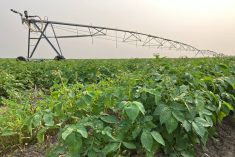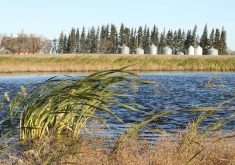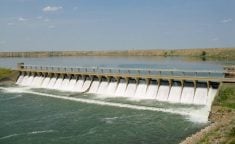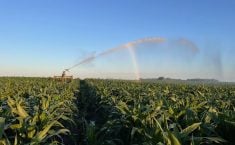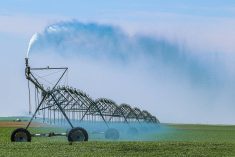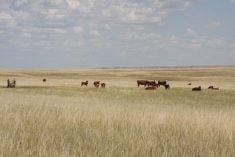The east side of Alberta could see revolutionary change if a $1.3-billion plan to irrigate 108,000 acres in the Special Areas and Municipal District of Acadia moves ahead.
“Special Areas has everything it needs to become a highly productive agricultural area – everything except a reliable supply of water,” Jordon Christianson, chair of the Special Areas board, said in a Dec. 5 news release.
“This project could reinvent what agriculture looks like in east-central Alberta, bringing new opportunities to producers passionate about agriculture.”
Read Also

Moo translator and methane measures: There’s an app for that
Dalhousie University researchers use artificial intelligence to create new dairy farm apps that analyze cattle sounds and measure methane.
A preliminary report released with little fanfare in late August backed that view, saying there is enough water available in the Red Deer River to irrigate 108,000 acres in the region.
But it comes with a steep price tag.
“In total, the probable capital cost of the project (at full buildout for 108,000 acres based on current conceptual design assumptions) was an estimated $1.3 billion, including 20 per cent contingency and 15 per cent for engineering,” said the preliminary report by Calgary-based consultants WaterSmart.
[RELATED] Irrigation districts laud provincial support of sector
That prompted the announcement earlier this month of a more detailed $7-million feasibility study funded by the province and MD of Acadia, which is getting a loan from the federal Canada Infrastructure Bank for the work. It will include preliminary engineering design, environmental and regulatory considerations, and potential financing options. This work is expected to take up to 24 months to complete.
The 108,000-acre project (49,200 acres in the MD of Acadia and 58,900 acres in Special Area No. 2) would be the maximum size. Shrinking it to 81,000 acres (by removing the highest-cost land to irrigate) would reduce the “probable” cost to just over $1 billion. Cutting it further to 49,200 acres (by developing in the MD of Acadia only) would reduce the cost to $387 million, the WaterSmart report states.
However, the potential cost for all three scenarios falls into a wide range. The 108,000-acre plan could cost anywhere from $1.2 billion to nearly $1.7 billion, the preliminary report states.
Big by any measure
“A large-scale irrigation project would increase water security and bring major economic benefits to agricultural producers while also enhancing recreational opportunities in the area,” Acadia reeve Peter Rafa said in the release.
[RELATED] The numbers keep getting bigger for irrigation
The WaterSmart report says that without the project, the economic outlook for this part of Alberta is not promising.

“Compared to the rest of the province, the region has seen a significant drop in natural gas production over the past five years,” the report states. “Projections indicate that gas production will continue to decrease by 57 per cent between 2020 and 2030 for the southeastern Alberta region.
“As a result of these significant changes in economic development opportunities, the population in these communities is forecasted to decrease more than anywhere else in Alberta over the next 25 years.”
If the full version of the irrigation project went ahead, it would cost even more than the $933-million expansion of irrigation in southern Alberta that is now underway. The province and nine irrigation districts (which also received a low-interest loan from the Canada Infrastructure Bank) have partnered on “the largest investment of its kind in Alberta history.”
There are a series of projects, some already completed, to replace canals with pipelines, build new reservoirs or expand existing ones.
Although the cost of the southern Alberta project is lower, it will add more irrigation acres — about 230,000 in total.
The 108,000-acre plan in the southeast would see irrigation in four “blocks” north and northwest of Medicine Hat in an area encompassing Hanna and Oyen. It would involve an intake and pump station on the Red Deer River, pipelines and two reservoirs (Reservoir A1 and Prince’s Spring Reservoir).
The potential benefits are enormous, Nate Horner, minister of the newly renamed Agriculture and Irrigation department, said in the news release.
“Historically, irrigation has been a game-changer when it comes to increasing sustainable primary crop production,” said Horner. “The east-central project has the potential to help grow the agri-food sector and support a diversified value-added processing industry.”
The WaterSmart report found there is enough cultivated land of suitable quality in the region and the project would not include native grasslands. It also said there’s enough water available for allocation in the Red Deer River Basin to support the project, with reservoirs on both sides of the river being “conceptually feasible” at the size required to support estimated irrigation demand.
The total operating expenses are estimated to range from $180 to $300 per acre annually, assuming a direct grid connection and market electricity rates for the project’s power supply. The per-acre price tag (not including on-farm costs) is estimated at $12,300 per acre for the 108,000-acre version.
The next step is to drill down into those numbers. The $7-million second phase of work will include optimizing the design, securing a water licence, preparing for regulatory approvals and refining the business case. The consultants also recommended that seasonal geotechnical and environmental field work be prioritized in preparation for design and regulatory applications.
Alberta is home to more than 1.8 million irrigated acres. A 2021 study found that Alberta’s irrigation districts create about 46,000 jobs and contribute about $5.4 billion in total gross domestic product.




